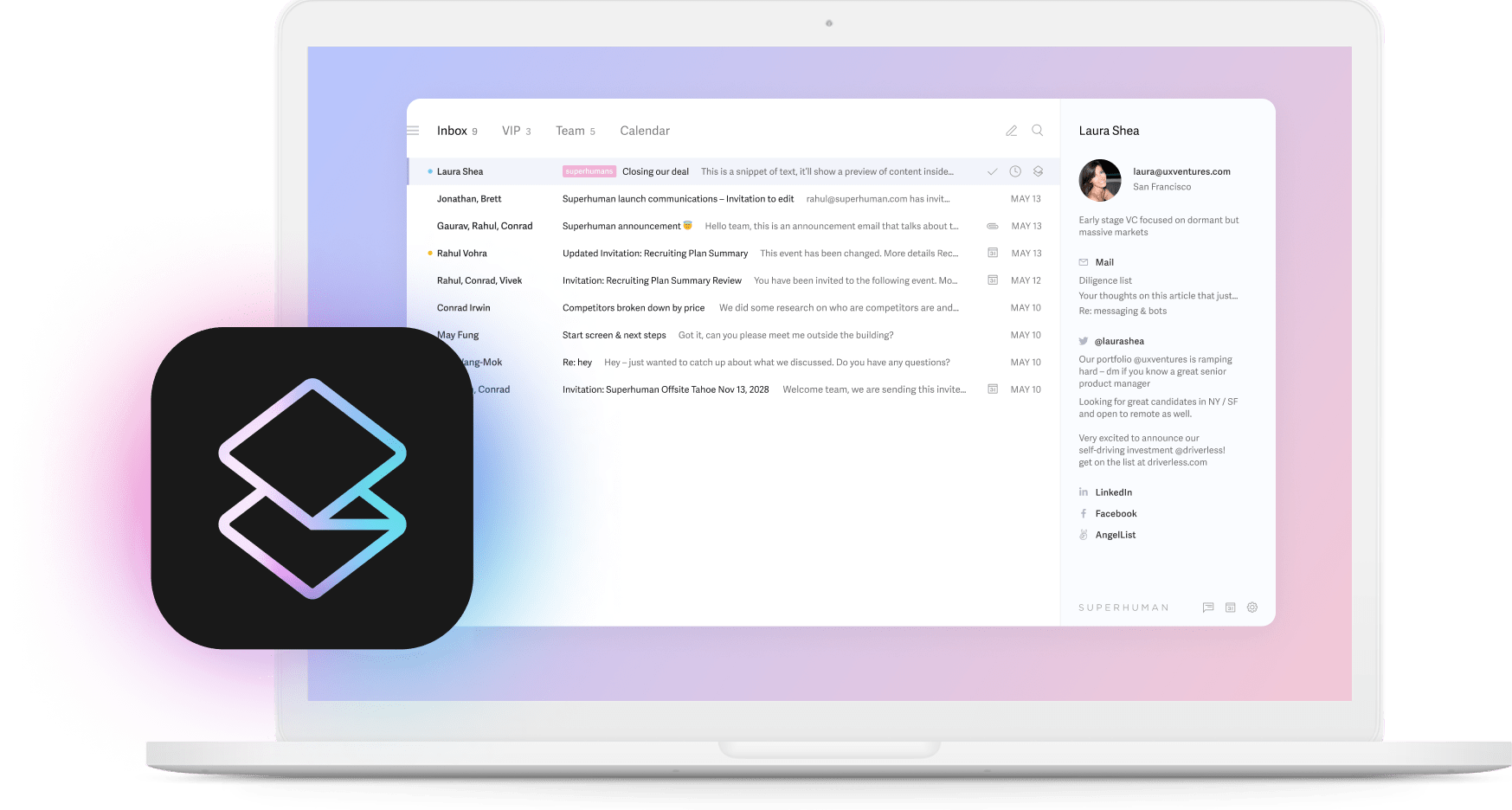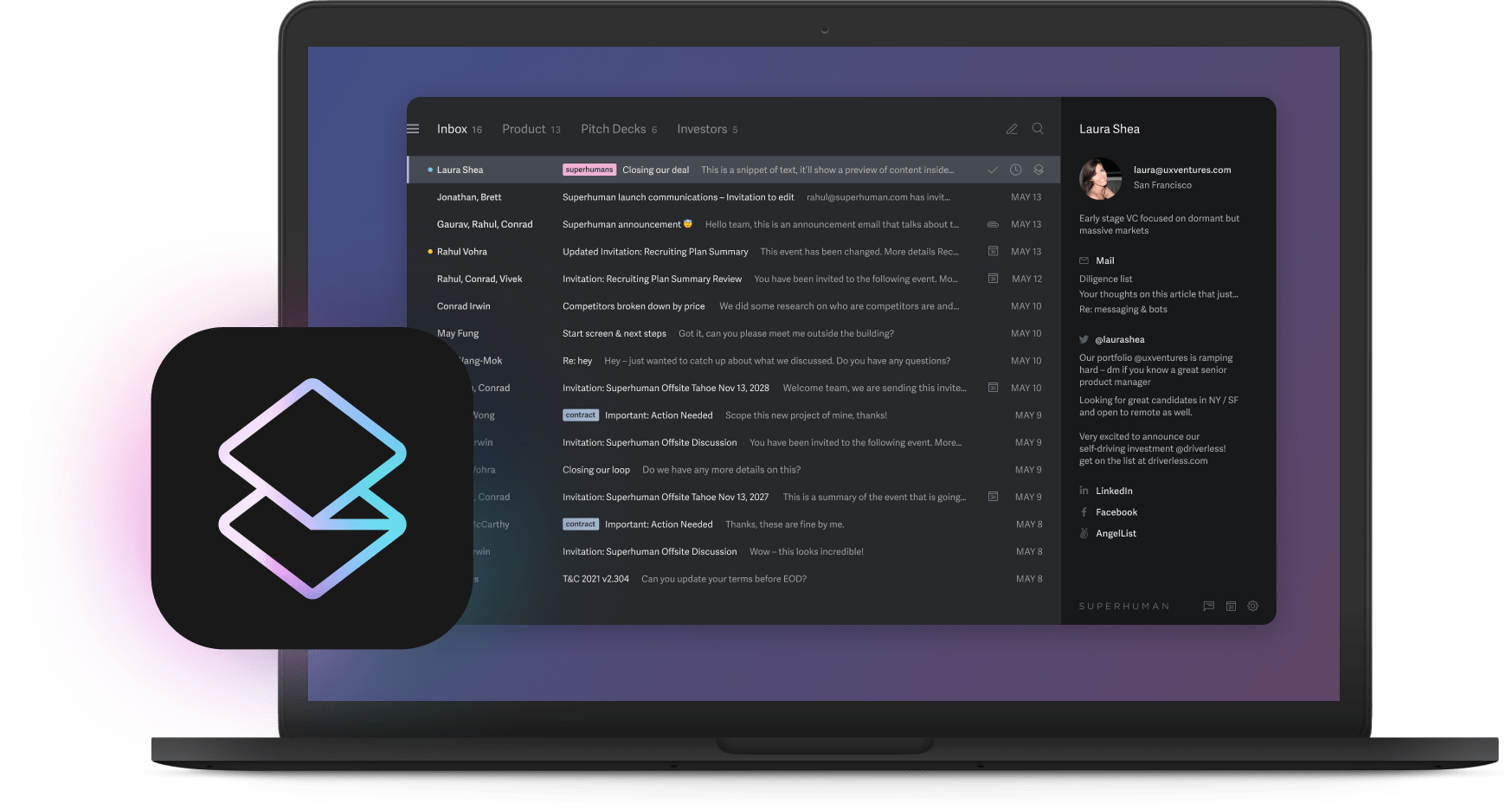
Growth feels amazing until you can't sleep. Triple your revenue, and complexity multiplies by nine. Your body keeps score in ways spreadsheets don't track. You get chronic fatigue, foggy decisions, weakened immunity, and Sunday anxiety that starts on Friday.
Most leaders think they need to work smarter or hire faster. They're wrong. The problem isn't your productivity system. It's that growth creates exponentially more complexity than humans can process. When your brain hits its biological limits, exactly when your company needs peak performance, you need systems that create a cognitive buffer between you and the chaos.
Otherwise, the business that once energized you becomes the thing that destroys your health. 82% of professionals already use AI in their email because they've discovered what you're about to learn: technology can process complexity at speeds your brain simply can't match.
The scale paradox: why 200% growth breaks everything
Something strange happens when companies cross 200% annual growth. The playbook that got you here stops working entirely, and understanding why is critical to your survival.
Triple your headcount, and you don't add teammates; you create a communication storm. Simple math: 3x people means 9x possible communication paths. Every new hire adds meetings, approvals, and decisions that fragment your attention further. This exponential complexity explains why you feel busier but less productive as you scale.
The breakdown happens because manual processes that worked at $5M revenue collapse at $15M. Spreadsheets can't track exploding SKUs. Email chains lose critical decisions. Teams default to firefighting because planning feels impossible when everything changes weekly. Your tools literally can't keep pace with your growth rate.
Here's the cruel irony: the human brain simply can't scale with the business. You hit cognitive limits exactly when the company needs your best thinking. Leaders log 60+ hour weeks while decision quality plummets. This isn't a time management problem, it's a biological constraint. Your neurons fire at the same speed whether you're running a $1M or $100M company.
WeWork and Starbucks learned this lesson publicly, expanding faster than their operating models could support. When dashboards celebrate vanity metrics without tracking cash burn or team health, you're trading sustainable growth for dangerous optics. The only escape route isn't working harder, it's building an AI-native sanity system that processes complexity so you don't have to. That's how you break free from the scale paradox.
Your burnout inventory (take this now)
Before diving into solutions, you need to know exactly how close you are to the edge. This inventory reveals whether you're managing growth stress or if it's managing you.
Physical signals: Your body broadcasts warning signs before your mind admits there's a problem. Sleeping less than 6 hours more than twice this week means your recovery system is failing. Persistent headaches, digestive issues, or back pain signal chronic stress overload. Relying on caffeine after 3 PM just to function shows your natural energy reserves are depleted. Canceling workouts because you're "too busy" removes the very activity that could restore your capacity.
Mental markers: Cognitive decline happens gradually, then suddenly. Reading the same email three times without comprehending means your working memory is overloaded. Forgetting important details you once tracked easily indicates decision fatigue has set in. Feeling disconnected from the mission you built suggests emotional exhaustion. Dreading Monday starting on Friday afternoon reveals your psychological reserves are empty.
Behavioral changes: Your actions expose what your mind denies. Checking email during every bathroom break shows compulsive behavior replacing intentional work. Snapping at team members over minor issues means your emotional regulation is compromised. Postponing personal commitments "just this once" (weekly) indicates work has consumed your identity. Working through vacation to "stay caught up" proves you've lost the boundary between recovery and performance.
Count your yes answers:
- 0-3: You're managing growth stress well
- 4-7: Yellow alert - intervention needed now
- 8+: Red zone - your health is actively at risk
If you're in yellow or red, what follows isn't optional. It's survival. The next section shows exactly how to pull back from the brink while maintaining your company's momentum.
The growth survival framework: three phases for sustainable scaling
Three phases consistently pull executives back from the edge of burnout while maintaining growth momentum. Each phase builds on the previous one, creating a sustainable system that scales with your company.
Phase 1: Recovery mode (start here if you're drowning)
You can't fix systems when you're running on fumes. Recovery comes first because your brain needs baseline energy to make good decisions.
Tonight, activate email triage to stop the bleeding. In Superhuman, turn on Split Inbox. Important emails surface, newsletters hide. Just this change saves 2 hours tomorrow because you're no longer wading through noise to find signal.
Why does this work so fast? Set Auto Reminders on everything non-urgent. Your brain stops tracking 50 open loops. Mental RAM clears for actual thinking. The constant background anxiety of "what am I forgetting?" disappears.
This weekend, take 24 hours completely offline. Not "checking occasionally." Off. Your team will survive because most "emergencies" aren't. Your nervous system needs this reset to break the cortisol cycle that's keeping you wired but tired.
Phase 2: Handoff rituals (week 2-4)
With basic energy restored, systematically remove low-value work from your plate. This isn't delegation for delegation's sake; it's strategic capacity building.
List every task you touched last week. Mark each as "only me" or "anyone trained." That second pile represents hours you're stealing from strategic work. Create Snippets for common responses so even custom emails take seconds. Let Auto Summarize compress long threads into scannable bullets, turning 10-minute reads into 30-second scans.
The game-changer comes from building one source of truth in Coda or similar. When sales data, product metrics, and financial dashboards live in one place, you stop the six-tab scavenger hunt for basic numbers. Decisions accelerate when information is instant. More importantly, your team stops interrupting you for data they can now access themselves.
Leaders who consolidate their data sources report significant reductions in time spent searching for information. Team velocity often increases because leadership can focus on strategy instead of administration. You're not just saving time, you're multiplying your impact.
Phase 3: Intelligent systems (month 2+)
Now you build the cognitive buffer that makes hypergrowth sustainable long-term. This is where AI transforms from nice-to-have to competitive advantage.
Your email becomes self-managing through intelligent automation. Instant Reply learns your voice and drafts responses that sound like you, not a robot. This matters because maintaining relationships while scaling requires personal touch at inhuman speed. Read Statuses show exactly when to follow up, eliminating the mental load of tracking who needs nudging when.
Connect your workspace to live data feeds for predictive insights. When AI flags that engineering velocity dropped 23% or customer response times are creeping up, you catch problems before they explode. Pattern recognition that would take you hours happens in milliseconds. You shift from reactive firefighting to proactive leadership.
Let machines handle first drafts of routine communications. Board updates, team announcements, customer responses become 10-minute polishes instead of hour-long writing sessions. Teams using these approaches already save 1 day weekly. That recovered time goes directly into the strategic thinking that only you can provide.
The compound effect is dramatic. You're not just saving time, you're preserving cognitive capacity for the decisions only you can make. That's how you scale yourself alongside your company.
Daily protocols that prevent relapse
Hypergrowth never pauses, so your recovery system can't either. These daily minimums keep burnout at bay by creating sustainable rhythms that protect your cognitive capacity while maintaining momentum.
Morning (10 minutes): Start with Split Inbox, not the full firehose. Scan only the "Important" section. Everything else waits. This boundary trains your brain that you control the day, not the inbox. Why this matters: starting with filtered priorities instead of random urgency sets the mental tone for strategic thinking rather than reactive scrambling.
Midday (90 minutes): One protected thinking block. No meetings, no Slack, no "quick questions." Book it as "Board Strategy" so nobody dares interrupt. This is where breakthrough decisions happen because your brain finally has space to connect dots instead of just collecting them. Skip this and you'll make surface-level choices that create tomorrow's fires.
Evening (5 minutes): Let Auto Summarize scan what you skipped. Quick review ensures nothing critical fell through while proving most "urgent" items weren't. Log off knowing tomorrow is handled. This closure ritual stops your brain from background processing all night, which is why you wake up exhausted even after eight hours of sleep.
Skip these protocols and you'll slide back into chaos within two weeks. They're not optional habits, they're your immune system against burnout. The structure creates freedom by removing thousands of micro-decisions about when to check email or how to prioritize. That recovered mental energy goes into the big decisions that actually move your company forward.
The false fixes that make everything worse
Three tempting "solutions" actually accelerate burnout by adding complexity instead of removing it. Understanding why they fail helps you avoid these expensive mistakes.
Hiring sprees without onboarding systems create more problems than they solve. Each new person adds questions, misalignments, and cultural drift. You spend more time managing than building because every hire needs context you haven't documented. The result? You're working harder to accomplish less while your culture dilutes with each addition.
Tool proliferation multiplies complexity exponentially. When every team picks different software, you're juggling 15 dashboards to understand your own company. Integration nightmares multiply because nothing talks to anything else. You've transformed from CEO to chief tool wrangler, spending hours just trying to find basic information scattered across platforms.
Surface wellness perks insult intelligence while ignoring root causes. Yoga Wednesdays and meditation apps can't offset 80-hour weeks. Real wellness means structural changes to how work flows, not band-aids on broken systems. Many companies install wellness amenities while maintaining unsustainable work cultures. When half the leadership team experiences burnout symptoms, perks without systemic change fool no one, especially not your body.
These false fixes share a fatal flaw: they treat symptoms while worsening the underlying disease. Each adds tasks to your plate instead of removing them. Real solutions subtract complexity rather than disguising it. That's why AI-powered systems work where these Band-Aids fail, they eliminate work rather than reorganizing it.
Measuring what matters: your growth health dashboard
Track these five metrics monthly to catch burnout before it catches you. Each metric serves as an early warning system for different aspects of sustainable scaling.
Sleep average reveals your recovery capacity. Anything under 6 hours predicts bad decisions and health crashes because your brain literally can't form memories or process emotions properly on insufficient sleep. Track this religiously, it's your canary in the coal mine.
Decision velocity measures organizational health. Time from question to answer should decrease as systems improve. If it's taking longer to make calls as you grow, your infrastructure isn't scaling with your ambitions. Fast decisions with good information beat perfect decisions made too late.
Energy audit captures what numbers miss. Rate your energy 1-10 each Friday. Watch for downward trends because energy decline precedes performance decline by weeks. When leaders feel energized, companies move faster. When they're depleted, everything slows.
Weekend work hours exposes work-life integration failures. Target under 2 hours, zero is better. If you're consistently working weekends, you're borrowing from future capacity at compound interest rates. That debt always comes due, usually at the worst possible moment.
Team health pulse predicts your future state. Anonymous survey on burnout symptoms because their stress predicts yours. Burned out teams create burned out leaders through increased firefighting and decreased performance. Healthy teams create breathing room for strategic work.
When two or more metrics flash red, return to Phase 1 immediately. Don't negotiate with these numbers or rationalize them away. Growth at the cost of health isn't growth, it's a countdown to collapse. These metrics keep you honest when ambition tries to override wisdom.
The compound effect of sustainable scaling
Most hypergrowth leaders don't realize that burning out doesn't just hurt you. It actually caps your company's potential in ways that become irreversible.
Exhausted leaders make poor decisions that cascade through organizations. They hire badly because they're too tired to properly vet candidates. They react slowly to market changes because processing new information feels overwhelming. They model unsustainable behavior that becomes company culture. Teams mirror leadership, creating company-wide burnout that kills innovation and drives away top talent who have better options.
But leaders who build cognitive buffers create the opposite cascade. They see around corners because they have mental space for pattern recognition. They make strategic bets while competitors fight fires. They attract A-players who want to work for someone who's thriving, not just surviving. Energy is contagious, and when leadership radiates sustainable success, it permeates everything.
The math is compelling for skeptics who need numbers. Save 20 hours weekly through intelligent systems. That's 1,000 hours annually, enough to develop new products, explore new markets, or actually take that vacation. At a $500K salary, that's $250K in reclaimed leadership capacity. But the real value isn't in hours saved, it's in decisions improved. One strategic insight made with a clear mind can be worth millions. One bad call made while exhausted can cost everything.
More importantly, you model what sustainable success looks like. Your team learns that peak performance doesn't require self-destruction. That culture becomes your competitive moat because burned-out competitors can't match the innovation speed of energized teams. This isn't just about personal health, it's about building a company that can sustain its growth trajectory without destroying the people who fuel it.
Start here, tonight
If you're drowning in hypergrowth chaos, you don't need another productivity framework. You need immediate relief and sustainable systems. Here's exactly what to do, in order, to begin your recovery.
Tonight: Install Split Inbox to immediately reduce email overwhelm. Set up Auto Reminders so your brain stops tracking every open loop. Schedule your 24-hour offline window for this weekend. These three actions take 30 minutes but create instant mental relief.
This week: Map your tasks into "only me" and "anyone trained" buckets. Hand off the second pile because every task you shouldn't be doing steals time from tasks only you can do. The clarity from this exercise alone often recovers 10+ hours weekly.
This month: Build your cognitive buffer with AI tools that process complexity so your brain doesn't have to. As systems take over routine work, you'll notice energy returning, sleep improving, and strategic clarity emerging. Most professionals using these approaches already save 1 day weekly.
Your company's growth shouldn't cost your health. With the right systems protecting your cognition, hypergrowth becomes what it was meant to be: the most exhilarating phase of your career, not a slow-motion crisis. The choice is yours. Keep white-knuckling through each day, or build systems that let you scale sustainably. Your future self, your family, and your company will thank you for choosing wisely.
The difference between leaders who burn out and those who break through isn't talent or determination. It's having the wisdom to build systems that protect their most valuable asset: their cognitive capacity. Start tonight. Your recovery begins with a single click.






